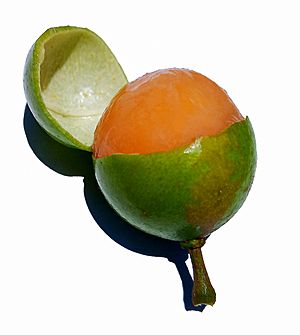Bajan ackee facts for kids
Quick facts for kids Bajan ackee |
|
|---|---|
 |
|
| Leaves and fruit | |
| Conservation status | |
| Scientific classification | |
| Genus: |
Melicoccus
|
| Species: |
bijugatus
|
| Synonyms | |
Melicoccus bijugatus is a fruit-bearing tree that belongs to the soapberry family, called Sapindaceae. This tree grows naturally in warm, tropical parts of the New World. You can find it in South and Central America, and on many Caribbean islands. Its fruits have a hard seed inside and are safe to eat. This tree is known by many names, like Bajan ackee, genip, guinep, quenepa, chenet, and mamoncillo.
Contents
Understanding the Genip Tree's Name
The group of trees this plant belongs to, Melicoccus, was first described in 1756. This was done by an Irish doctor and plant expert named Patrick Browne. He studied M. bijugatus trees growing in Puerto Rico.
Later, in 1760, Nikolaus Joseph von Jacquin gave the first official name to a species in this group: M. bijugatus. For a long time, people used a slightly different spelling, Melicocca bijuga. However, the original spelling, Melicoccus, was brought back.
The second part of the name, bijugatus, describes the tree's leaves. It means "two pairs of leaflets." So, each leaf has four smaller leaf parts arranged in two pairs.
Where Does the Genip Tree Grow?
Melicoccus bijugatus is originally from northern South America. It has also spread and grown wild in other places. These include coastal and dry forest areas in Central America, the Caribbean, and even parts of the Old World tropics, like India.
People believe this fruit arrived in the Caribbean a very long time ago, even before Christopher Columbus. In Puerto Rico, the fruit is called quenepa. It grows especially well in the city of Ponce. Ponce even has a special yearly event called the Festival Nacional de la Quenepa (National Genip Fruit Festival). The fruits usually become ripe during the warm summer months.
What Does the Genip Tree Look Like?
These trees can grow very tall, up to about 25 meters (82 feet). They have leaves that grow in an alternating pattern along the branches. Each leaf is made up of four oval-shaped leaflets. These leaflets are usually 5 to 12.5 centimeters (2 to 5 inches) long and 2.5 to 5 centimeters (1 to 2 inches) wide.
Most genip trees have separate male and female plants. This means you need both a male and a female tree for fruit to grow. However, sometimes a single tree can produce fruit on its own. The flowers have four petals and eight stamens. They grow into round, green fruits. These fruits are about 2.5 to 4 centimeters (1 to 1.5 inches) long and 2 centimeters (0.8 inches) wide. Inside, the fruit's pulp can be orange, salmon, or yellowish. It has a juicy, somewhat pasty texture.
The Genip Fruit
The genip fruit is round and has a thin, easy-to-break green skin. It is usually 2 to 4 centimeters (0.8 to 1.5 inches) across. Most of the fruit is taken up by one (or sometimes two) whitish seeds. These seeds are surrounded by a tasty, orange, juicy, and jelly-like pulp. In places like Puerto Rico and Florida, people are trying to grow new types of genip trees. They want to create fruits with more edible pulp and smaller seeds.
When the fruits are ripe, they have a bittersweet, wine-like taste. They can also act as a mild laxative. Genip fruits are very rich in important minerals like iron and phosphorus. Be careful when eating them, as the slippery seed can be a choking hazard. The fruits are ready to eat during the dry season or summer.
How Are Genip Trees Used?
The main use for the genip fruit is eating it fresh. People also can it or use it to make soft drinks and alcoholic beverages. The fruit can also produce a strong yellow dye, but this is not a common use.
The seed inside the fruit is also edible! When roasted, it tastes a bit like cashew nuts. Some native groups living near the Orinoco river eat the roasted seeds as a replacement for cassava. In Nicaragua, people grind the seeds to make a drink called horchata. This drink is sometimes used as a traditional remedy for certain health issues.
The wood from the genip tree is light in color, dense, and moderately heavy. It has a fine grain. People use it for building, carpentry, and making nice furniture. However, it doesn't last very long outdoors, so it's mostly used for indoor projects.
The leaves of the genip tree are used in some traditional medicines. They are also used to keep pests away. The tree is often planted along roadsides because it is a beautiful ornamental tree.
Genip in Popular Culture
The quenepa fruit is often mentioned in songs and stories in the Spanish Caribbean. For example, the Puerto Rican rapper René Pérez (Residente) mentions it in his song Suave.
See also
 In Spanish: Melicoccus bijugatus para niños
In Spanish: Melicoccus bijugatus para niños




